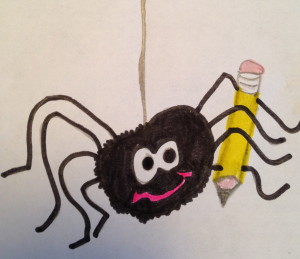 “Writing is slow. If you want fast, bake a cake.” Linda Sue Park
“Writing is slow. If you want fast, bake a cake.” Linda Sue Park
Crafting a book takes a very long time. As writers, we agonize over word choice and sentence structure, delete paragraphs, (and put them back in), change points of view, flesh out characters, and do tons of research. We write and revise, get feedback from fellow writers, revise again, submit to editors and agents, and revise some more. We spend weeks, months, even years doing this with no promise of publication. To quote Karla Kuskin, “It’s not so much about the writing as it is about the rewriting.”
For the past three years, this is exactly what I’ve been doing with my two middle grade novels. I’ve been intensely focused on the “re’s”: rereading, rewriting,researching, revising, repeat. And although I enjoy this part of the writing process, I desperately needed a break from the slow sculpting of my stories. I wanted to race, to fly, to write non-stop with sheer abandon. And so, in November, I took the plunge and signed up for that world famous writing marathon, NaNoWriMo– National Novel Writing Month. Its challenge: 30 days, 50,000 words, No excuses. It was time to hunker down, leave the laundry to pile up, and crawl into the speed-writing cave.
I know it sounds crazy. Why would someone like me, a total “planner,” not a “pantser,” spend an entire month spewing out words that might be twisted, tweaked, and possibly eliminated in the revision process? Why take my carefully plotted, five-page, single-spaced, 27-chapter outline and punch out a first draft in only 30 days? Hmm… why not?
Let’s face it; first drafts are messy. Whether it takes 300 days or 30 days, all manuscripts morph and change. But first, you must get that story out of your head and onto your computer screen (or on paper if you’re more old-school). So why not opt for the 30 day version? After all, it’s only ONE month of your long, slow life as a writer. What do you have to lose?
Many of my fellow writers think this manic activity is pure lunacy. But I say, don’t knock it ‘til you’ve tried it. (I’ve never run a marathon, but I think theNaNoWriMo adrenaline rush might be just as satisfying.)
Okay, so now that I’ve convinced you to give this thing a try (maybe), here are a few helpful tips:
1. Go to the www.nanowrimo.org website and look around. Watch out, there are graphs!
2. Read the pep talks. They are INSPIRATIONAL AND HILARIOUS.
3. Find some brave writing souls to join you in this madness (I mean writing endeavor).
4. Have a story somewhere in your brain that is screaming to get out.
5. Have a general idea of your book’s beginning, middle, and end. (Remember my 27-chapter outline?) And have a problem for your main character to solve (this may change).
6. Make plans to attend a “Write-In” near your house (or virtually) to meet other wild and wacky NaNo’s.
7. Do some timed word sprints to get into the speed-writing mode. My favorite is 40 minutes, timed on my phone, which actually gets me to crank out 1000 words!
This is what happened to me and might happen to you if you do this:
1. I was totally immersed in my story, night and day, for all 30 days.
2. My characters came to life and led me to surprising and unplanned places.
3. Everything in my story was more emotional than I had anticipated. I laughed, gasped, and even shed a few tears along the way.
4. The laundry got done.
And here’s the best part. Because I finished before midnight on November 30, I am a WINNER! A group of NaNo’s even sent me a congratulatory video. (I also bought the tee shirt.) So now what? What am I going to do with this 50,000 word-ramble about worries, dream journals and friend problems? Go back to my “re” life, of course. I will reread, revise, research, and repeat. NaNo On!!

